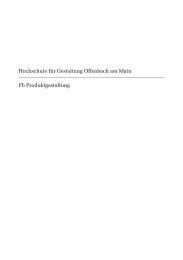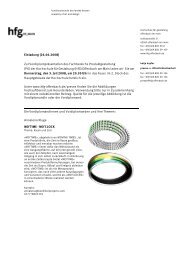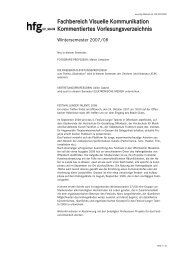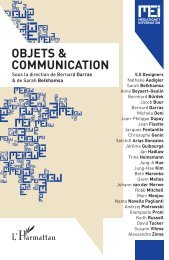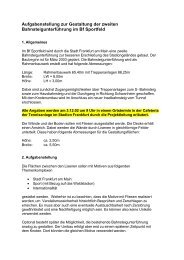User Manual
User Manual
User Manual
You also want an ePaper? Increase the reach of your titles
YUMPU automatically turns print PDFs into web optimized ePapers that Google loves.
OTF<br />
Off The Film - the original literal description of the light measurement<br />
mechanics regarding flash exposure measurement that now<br />
applies to digital sensors too.<br />
Profile<br />
You can allow the H3D II to be set according to ‘profiles’. These<br />
profiles are combinations of modes, methods and settings (custom<br />
or default) that suit specific photographic situations. By using<br />
a personal profile - which you can create, name and save - the<br />
camera is immediately configured for a specific purpose without<br />
any need to check through the menus. This is a very rapid and<br />
secure way of working when repeatedly confronted with similar<br />
photographic situations.<br />
As an example you might regularly take outdoor portraits of<br />
wedding couples with a long lens. You want a specific aperture to<br />
restrict depth-of-field and a fairly fast shutter speed to freeze any<br />
movement. You are concerned about the couple blinking during the<br />
exposure and so want to take several shots in succession, possibly<br />
with slight variations in exposure settings for safety’s sake so you<br />
might choose the bracketing option too. All these parameters can<br />
be preset and stored as a profile that is rapidly accessible.<br />
Quick save<br />
When altering settings, a half-press of the shutter release button<br />
will cause a return to the main screen and save the new setting at<br />
the same time.<br />
Standard exposure<br />
A ‘standard exposure’ in the manual refers to the concept of<br />
technically correct in accordance with internationally accepted<br />
photographic measurement standards (see section on Mid-grey /<br />
18% grey). This does not imply, however, that it would automatically<br />
be the preferred choice or be ‘correct’ according to the desired<br />
result. See section on Bracketing.<br />
Main screen<br />
To simplify the descriptions, reference is often made to a ‘main’<br />
screen regarding the menu. Apart from default settings, there is no<br />
standard setting in the normal sense and therefore you create your<br />
own ‘standard’, which of course can be changed at any time.<br />
The ‘main’ screen is therefore the one you have currently created<br />
and is the one visible on the display when photographing (except<br />
where a particular mode is in actual operation, such as self-timer,<br />
for example).<br />
TTL<br />
Through The Lens - a literal description of the light measurement<br />
mechanics. The advantage is that only the essential parts of the<br />
subject in front of the camera are included. Accessories such as<br />
filters, bellows, close-up rings, converters, etc that could affect<br />
exposure are also taken into account automatically with exposure<br />
evaluation (for general purposes).<br />
119<br />
Tethered / Untethered<br />
When the H3D II saves digital files directly to a computer - it is<br />
described as tethered..<br />
When files are saved to an internal CF card or an ImageBank II,<br />
it is described as untethered.<br />
Time out<br />
This is the time interval that a temporary setting is maintained<br />
for before it automatically returns to the original setting (default<br />
or custom).<br />
Zone (system)<br />
The Zone System is a method of combined exposure calculation/<br />
film development providing a great deal of tonal control. It was<br />
originally devised by Ansel Adams - the classic landscape photographer<br />
and Hasselblad user - and now exists in various forms<br />
for both black & white and colour photography.<br />
Naturally in the case of the H3D II or any other digital camera,<br />
the film development part of the method can not apply. However,<br />
some photographers are used to its philosophy and are familiar<br />
with its terminology and might like to still refer to it.<br />
An integral part of the method includes the classification and<br />
grouping of any given scene into a range of nine (or ten) so-called<br />
zones, hence the name. Concerning the H3D II, the word zone<br />
refers to the grouping and classification of various tones, where<br />
Zone V is the equivalent (whether in black & white or colour) to<br />
18% mid-grey on a scale of Zone I (black) through Zone IX (white).<br />
See specific literature for a complete description of this method.<br />
3F / 3FR<br />
The H3D II produces Hasselblad 3FR files after capture. These<br />
RAW format files are automatically converted into 3F files when<br />
imported to a computer using Phocus or FlexColor.



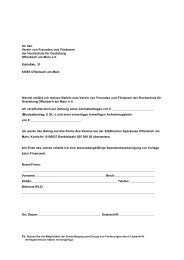
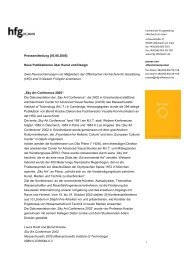
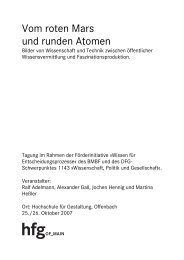
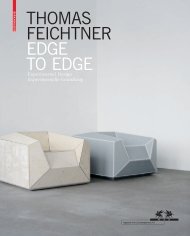
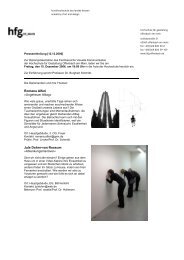

![Einladung [07.02.2006] - Hochschule für Gestaltung Offenbach am ...](https://img.yumpu.com/13375413/1/184x260/einladung-07022006-hochschule-fur-gestaltung-offenbach-am-.jpg?quality=85)
